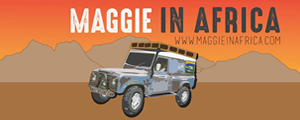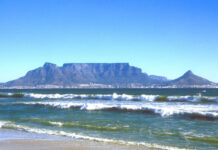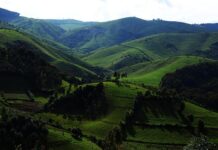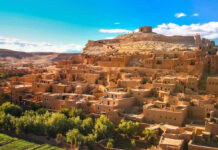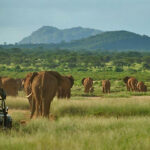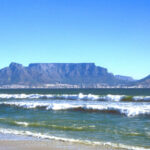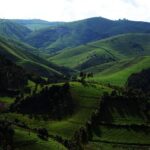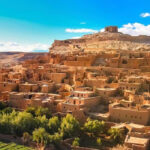Gaborone – Botswana’s sleepy capital city of only 200,000 residents – may not be high on everyone’s travel bucket list. But ‘Gabs’, as it’s affectionately known by locals, makes for a convenient stop-over while travelling to points north (Maun, Kasane, etc), or south (South Africa and Johanesburg), so many overlanders and tourists find themselves in the city.
Noel and I have lived here for two years, and are spending 3-4 weeks here while we’re getting Maggie ready for the big trip. So we think we know the city quite well.
For those that find themselves here for a couple of days or more, here is a short list of our favourite things to do in the city:
1. Climb Kgale Hill
Marking the southern edge of Gaborone, Kgale Hill is not only one of the most prominent land marks, but the summit also offers stunning views of the city overlooking the Gaborone Dam.
The one-hour climb to the top is along a well-marked trail, but can be either easy or challenging depending on the detour taken, making it both a popular picnicking spot and fitness activity.
We love climbing Kgale, which literally means ‘the place that dried up’ in Setswana, in the early mornings (0:600-08:00hrs) when the weather is cool and refreshing. If you can make it up earlier, the views of the sunrise are stunning!
Our advice: if you’ve never climbed the hill before, plan to head up early on a Saturday or Sunday morning when there are sure to be others climbing at the same time. At other times, mind the baboons and don’t be too ostentatious in what you bring with you, especially if you’re climbing alone, as muggings are not unheard of at night and during off-peak climbing times. It’s also good to wear sneakers / hiking boots, because the trail can be very rocky in places.
Directions: To get to the hill, drive behind Game City shopping mall and park in the open space in front of the quarry buildings. Then enter the trail between the rubbish bin and the sign that is meant to warn visitors when blasting is taking place. The trail follows a blue fence, until it heads up and to the right. From there, follow the paths marked with white arrows. About half way up, along the ‘easy’ route, you’ll reach a fence with a dip and a concrete path. Turn up and to the left, and carry on until you reach the summit!
2. Shop for authentic African souvenirs
For those who are interested in souvenirs and handicrafts from across the country, Gaborone is a great place to shop. But don’t be fooled by the ‘pop up’ shops filled with similar looking souvenirs lining Gaborone’s shopping malls! Fair warning: many of these are sourced from China / India.
Instead, head to these places to get your fix of locally-made momentos, including traditional baskets, pottery and even quilts!
Botswanacraft
Botswanacraft Marketing located off the Western Bypass (A1) and in the airport is great for those looking for authentic souvenirs. The shop was originally established in 1970 to help develop the rural handicraft industry, but is now the country’s largest retailer and exporter of traditional crafts. Here, you can buy traditional and handmade handicrafts from across the country – including San jewellery, painted ostrich eggs, and traditional baskets.
- Botswanacraft entrance
- Traditional, handmade San jewelry
- Traditional hand-woven baskets
Kalahari Quilts
Kalahari Quilts are handmade by Batswana women, trained and overseen by the lovely Jenny Healy. Each piece is uniquely handmade, inspired by the colours and landscapes of Botswana, and often feature traditional fabrics, sunsets, people and animals.
Jenny has also recently launched a new made-and-designed-in-Botswana fabrics line, so pop into her shop in Kgale View for a chance to grab some pieces hot off the press! (Note: the shop is planning to move locations this year, so check the website for updates).
- Wall hanging from Kalahari Quilts
- Bed spread from Kalahari Quilts
- Wall hanging from Kalahari Quilts
Thamaga and Gabane Pottery
For those that have some extra time to go straight to the source, check out one or both of these pottery workshops a short drive west of Gaborone along the road to Kanye. In Thamaga, a small village 40km west of Gaborone, lies the Botswelelo Centre where Thamaga Pottery is made by local women. There is a showroom, and for only P20 you can book a tour of the workshop and pottery-making process, and even try your hand at making some yourself!
If 40km is too far, the Pelegano Village in Gabane is much closer to Gabs (20km), but there is no workshop tour available, and the ‘village’ seemed to be becoming overrun by industrial undertakings when we last visited. Of course, for those under time pressure, Thamaga and Gabane pottery can be purchased at Botswanacraft in their main shop off of the Western Bypass, or at the airport.
- Gabane Pottery
- Thamaga Pottery
- Thamaga Pottery
Oodi Weavers
Lentswe-la-Oodi Weavers, about 20km north of Gaborone on the road to Francistown, was established in 1973 as a cooperative. Most of the weavers currently running the cooperative are women, and produce handwoven and locally designed tapestries, wall hangings, and other home goods. The wool is hand-woven and hand-dyed at the workshop, where visitors receive tours by the weavers themselves. And because they are a cooperative, all the profits go to the weavers.
Farmer’s Markets
Farmer’s Markets are held on the last Sunday of each month at the Bull and Bush, one of the city’s oldest restaurants off of Nelson Mandela Drive. Visitors – expats, locals and tourists alike – can expect a good array of handicrafts and local food for sale at these colourful markets, run by Julia Farmer. Check out the Facebook page for more details on upcoming markets and venue changes.
3. Go for a game drive
Yes, you heard us right. A game drive. In the city.
There are no less than three establishments where you can get your fix of African wildlife in, or very near to, Gaborone.
Gaborone Game Reserve
Those interested in herbivores and bird watching will love the Gaborone Game Reserve, located in Broadhurst. The reserve is a 5 square kilometres, and was established by the Kalahari Conservation Society in 1988 to allow urban dwellers to enjoy the wildlife. The reserve costs only P10 per person (plus P10 per car), and has zebra, wildebeest, kudu, eland, ostriches, warthogs and an array of bird life. The reserve is also accessible by 2WD, making it a popular picnic spot as well.
- Impala
- Entrance, Gaborone Game Reserve
- Zebras, warthogs and impala
Mokolodi Nature Reserve
For those passing through Gaborone, the Mokolodi Nature Reserve is a must-see destination located just 20km south of the capital city.
Mokolodi is a private reserve that offers a number of tourist activities – including game drives, rhino and giraffe tracking and horseback safaris – to support its conservation and education programmes. Sun downers at the Mokolodi Tea Garden are also highly recommended!
Lion Park Resort
Better known among locals for its adjacent amusement park, this resort located about 24km south of Gaborone also keeps a number of domesticated lions which are available for viewing for just P35 per person. The closest you’re likely to get to the big five in the big city.
4. Eat like a local
Nothing beats eating like a local while travelling, and this is true in Gaborone, even though Botswana is not well known for its cuisine.
Like many African countries, Botswana’s traditional fare is based on combinations of meat and maize, also known locally as ‘Pap and Seswaa’ or beef stew. Goat meat or chicken stew are also very popular, almost always accompanied by maize meal and a vegetable – usually spinach (morogo) or butternut.
For the more adventurous souls, dried mopane worms are a national delicacy and can be found in large bags in the markets.
And for breakfast, try my favourite P3 treat: the fat cakes, or magwinya in Setswana.
The best place to get traditional food: try the hot bar at any supermarket during lunchtime hours, or alternatively try the Botswana Craft Courtyard Restaurant.
- Traditional meal
- Dried mopane worms
- Lady cooking fat cakes
5. Appreciate local art and culture
Although the arts scene in Gaborone is not nearly as happening as in neighbouring South African cities, there are still some highlights that are worthy of a visit. In particular, check if your visit coincides with the week-long Maitisong festival in April, or other plays put on throughout the year.
Alternatively, check out the following attractions, open year-round:
Thapong Visual Art Centre
The Thapong Visual Art Centre, located in the Village, is pretty much Gaborone’s only contemporary centre. Among other things, the centre is dedicated to developing Botswana contemporary art, helping artists pursue their careers, and educating budding artists through workshops and classes.
For visitors, the centre has a nice gallery displaying with exhibitions of the creme-de-la-creme of contemporary Batswana visual art, which is well worth a visit.
When you’re done soaking in the local art, enjoy a coffee or a sandwich at the neigbouring No. 1 Ladies’ Coffee House, named after the famous book series by Alexander McCall Smith. Sadly the No. 1 Ladies’ Opera House, which was well-known for its plays and cultural events, was closed for good a number of years ago.
National Museum and Art Gallery
Botswana’s modest National Museum, located in the centre of town off of Independence Avenue, has a nice display of traditional artifacts, crafts and paintings relevant to the country’s natural and cultural heritage.
Adjacent to the museum is the National Art Gallery, with permanent and rotating exhibitions of Batswana arts, crafts and photography – which makes for a nice peruse.
Dont’ forget to also visit the recently opened National Museum Botanical Gardens, which exhibit the flora of Botswana and historical buildings. The Gardens occupy 7 hectares along the Notwane River in the Village, near the Thapong Visual Arts Centre.
